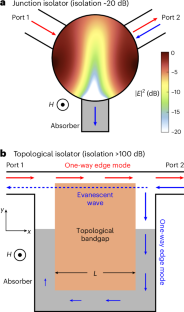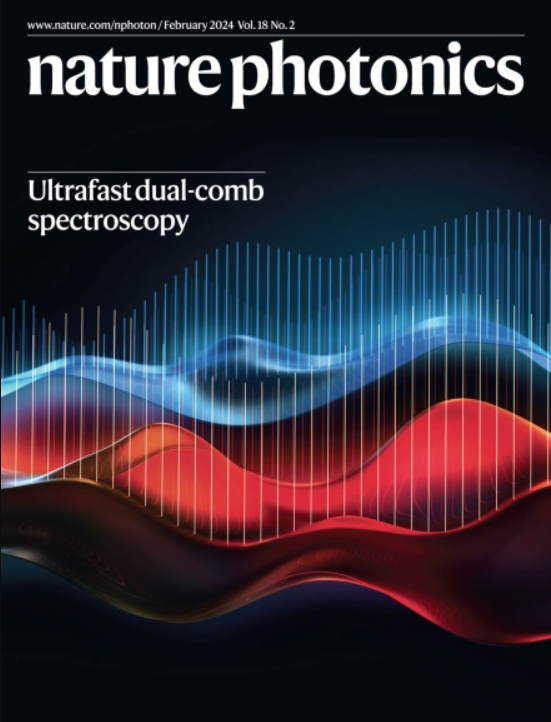Topological microwave isolator with >100-dB isolation
IF 32.9
1区 物理与天体物理
Q1 OPTICS
引用次数: 0
Abstract
Microwave isolators, developed after World War II, are essential non-reciprocal devices widely used to minimize signal reflections and interference across various applications, including mobile base stations, satellite communications, radar systems, magnetic resonance imaging and industrial microwave heating. A typical commercial microwave isolator provides 20 dB of isolation, reducing the backward power by two orders of magnitude. Although higher isolation is always desired for systems that require greater power or lower noise, such as superconducting quantum computing, further reduction in the backward signal will inevitably lead to an unacceptable degradation in the forward transmission in traditional designs. Here we introduce the principle of a topological isolator, based on a unique one-way edge waveguide that spatially separates forward and backward waves, allowing for the complete absorption of the backward-propagating mode without compromising any forward signal. This ideal isolation mechanism produces an unprecedented isolation level, analytically derived to be 200 dB within a single-wavelength-size device. It is limited only by the evanescent fields within the topological bandgap in the ferrite material that spans two octaves around 10 GHz. We experimentally demonstrate this topological isolator in a stripline configuration with a minimal insertion loss of 1 dB and a backward signal deeply attenuated to the instrument noise floor. This results in an ultrahigh isolation exceeding 100 dB—an eight-orders-of-magnitude improvement over conventional counterparts. Our work not only paves the way for higher-performance isolators in the aforementioned technologies but also sets the stage for innovation in a variety of related microwave components. Although typical microwave isolators provide 20 dB of isolation, a topological isolator—based on a one-way edge waveguide—enables 100 dB isolation due to the near-complete absorption of the backward-propagating mode. In theory, 200 dB of isolation is possible within a single-wavelength-size device.


拓扑微波隔离器>100-dB隔离
微波隔离器是第二次世界大战后发展起来的,是一种重要的非互反装置,广泛用于减少各种应用中的信号反射和干扰,包括移动基站、卫星通信、雷达系统、磁共振成像和工业微波加热。典型的商用微波隔离器提供20 dB的隔离,将反向功率降低两个数量级。虽然对于需要更大功率或更低噪声的系统,例如超导量子计算,总是需要更高的隔离,但在传统设计中,向后信号的进一步减少将不可避免地导致前向传输的不可接受的退化。在这里,我们介绍了拓扑隔离器的原理,它基于一个独特的单向边缘波导,在空间上分离正向和反向波,允许完全吸收反向传播模式,而不影响任何正向信号。这种理想的隔离机制产生了前所未有的隔离级别,在单波长大小的器件中,解析推导出的隔离级别为200 dB。它仅受限于铁氧体材料拓扑带隙内的倏逝场,该带隙跨越两个八度,约为10ghz。我们通过实验证明了这种拓扑隔离器在带状线配置下的最小插入损耗为1 dB,并且向后信号深度衰减到仪器噪声底。这导致了超过100 db的超高隔离度,比传统的隔离度提高了8个数量级。我们的工作不仅为上述技术中的高性能隔离器铺平了道路,而且为各种相关微波元件的创新奠定了基础。
本文章由计算机程序翻译,如有差异,请以英文原文为准。
求助全文
约1分钟内获得全文
求助全文
来源期刊

Nature Photonics
物理-光学
CiteScore
54.20
自引率
1.70%
发文量
158
审稿时长
12 months
期刊介绍:
Nature Photonics is a monthly journal dedicated to the scientific study and application of light, known as Photonics. It publishes top-quality, peer-reviewed research across all areas of light generation, manipulation, and detection.
The journal encompasses research into the fundamental properties of light and its interactions with matter, as well as the latest developments in optoelectronic devices and emerging photonics applications. Topics covered include lasers, LEDs, imaging, detectors, optoelectronic devices, quantum optics, biophotonics, optical data storage, spectroscopy, fiber optics, solar energy, displays, terahertz technology, nonlinear optics, plasmonics, nanophotonics, and X-rays.
In addition to research papers and review articles summarizing scientific findings in optoelectronics, Nature Photonics also features News and Views pieces and research highlights. It uniquely includes articles on the business aspects of the industry, such as technology commercialization and market analysis, offering a comprehensive perspective on the field.
 求助内容:
求助内容: 应助结果提醒方式:
应助结果提醒方式:


